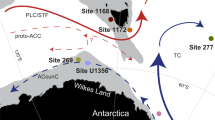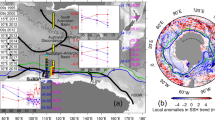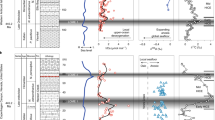Abstract
Deep-water formation in the northern North Atlantic Ocean and the Arctic Ocean is a key driver of the global thermohaline circulation and hence also of global climate1. Deciphering the history of the circulation regime in the Arctic Ocean has long been prevented by the lack of data from cores of Cenozoic sediments from the Arctic’s deep-sea floor. Similarly, the timing of the opening of a connection between the northern North Atlantic and the Arctic Ocean, permitting deep-water exchange, has been poorly constrained. This situation changed when the first drill cores were recovered from the central Arctic Ocean2. Here we use these cores to show that the transition from poorly oxygenated to fully oxygenated (‘ventilated’) conditions in the Arctic Ocean occurred during the later part of early Miocene times. We attribute this pronounced change in ventilation regime to the opening of the Fram Strait. A palaeo-geographic and palaeo-bathymetric reconstruction of the Arctic Ocean, together with a physical oceanographic analysis of the evolving strait and sill conditions in the Fram Strait, suggests that the Arctic Ocean went from an oxygen-poor ‘lake stage’, to a transitional ‘estuarine sea’ phase with variable ventilation, and finally to the fully ventilated ‘ocean’ phase 17.5 Myr ago. The timing of this palaeo-oceanographic change coincides with the onset of the middle Miocene climatic optimum3, although it remains unclear if there is a causal relationship between these two events.
This is a preview of subscription content, access via your institution
Access options
Subscribe to this journal
Receive 51 print issues and online access
$199.00 per year
only $3.90 per issue
Buy this article
- Purchase on Springer Link
- Instant access to full article PDF
Prices may be subject to local taxes which are calculated during checkout




Similar content being viewed by others
References
Aagaard, K. & Carmack, E. C. in The Polar Oceans and their Role in Shaping the Global Environment: The Nansen Centennial Volume (eds Johannessen, O. M., Muench, R. D. & Overland, J. E.) 5–20 (Geophysical Monograph 85, American Geophysical Union, Washington DC, 1994)
Backman, J., Moran, K., McInroy, D. B., Mayer, L. A. & the Expedition 302 Scientists Expedition 302 Summary. Proc. IODP 302 doi: 10.2204/iodp.proc.302.101.2006 (Integrated Ocean Drilling Program Management International, College Station, Texas, 2006).
Zachos, J., Pagani, M., Sloan, L., Thomas, E. & Billups, K. Trends, rhythms, and aberrations in global climate 65 Ma to present. Science 292, 686–693 (2001)
Lawver, L. A. & Scotese, C. R. in The Arctic Ocean Region, Geology of North America (eds Grantz, A., Johnson, G. L. & Sweeney, J. F.) Vol. L 593–618 (GSA, Boulder, Colorado, 1990)
Brozena, J. M. et al. New aerogeophysical study of the Eurasia Basin and Lomonosov Ridge: Implications for basin development. Geology 31, 825–828 (2003)
Vogt, P. R., Taylor, P. T., Kovacs, L. C. & Johnson, G. L. Detailed aeromagnetic investigation of the Arctic Basins. J. Geophys. Res. B 84, 1071–1089 (1979)
Moran, K. et al. The Cenozoic palaeoenvironment of the Arctic Ocean. Nature 441, 601–605 (2006)
Stein, R., Boucsein, B. & Meyer, H. Anoxia and high primary production in the Paleogene central Arctic Ocean: First detailed records from Lomonosov Ridge. Geophys. Res. Lett. 33 L18606 doi: 10.1029/2006GL026776 (2006)
Batten, D. J. in Palynology: Principles and Applications (eds Jansonius, J. & McGregor, D. C.) Vol. 3 1021–1064 (American Association of Stratigraphic Palynologists Foundation, Salt Lake City, 1996)
Williams, G. L. & Manum, S. B. Oligocene-early Miocene dinocyst stratigraphy of Hole 985A (Norwegian Sea). Proc. ODP Sci. Res. 162, 99–109 (1999)
Lourens, L., Hilgen, F., Shackleton, N. J., Laskar, J. & Wilson, D. in A Geologic Time Scale 2004 (eds Gradstein, F., Ogg, J. & Smith, A.) 409–440 (Cambridge Univ. Press, Cambridge, UK, 2004)
Jokat, W., Weigelt, E., Kristoffersen, Y., Rasmussen, T. & Schöne, T. New insights into the evolution of the Lomonosov Ridge and the Eurasian Basin. Geophys. J. Int. 122, 378–392 (1995)
Langinen, A. E., Gee, D. G., Lebedeva-Ivanova, N. N. & Zamansky, Y. Y. Velocity structure and correlation of the sedimentary cover on the Lomonosov Ridge and in the Amerasian Basin, Arctic Ocean. (Fourth Int. Conf. on Arctic Margins, ICAM IV, Dartmouth, Nova Scotia, Canada, 2006); 〈http://www.mms.gov/alaska/icam/〉.
Dixon, J., Dietrich, J. R. & McNeil, D. H. Upper Cretaceous to Pleistocene sequence stratigraphy of the Beaufort-Mackenzie delta and banks areas, northwest Canada. Geol. Surv. Can. Bull. 407, 1–52 (1992)
Lane-Serff, G. F. Topographic and boundary effects on steady and unsteady flow through straits. Deep-sea Res. II 51, 321–334 (2004)
Pratt, L. J. Recent progress on understanding the effects of rotation in models of sea straits. Deep-sea Res. II 51, 351–369 (2004)
Klenke, M. & Schenke, H. W. A new bathymetric model for the central Fram Strait. Mar. Geophys. Res. 23, 367–378 (2002)
Rudels, B., Jones, E. P., Anderson, L. G. & Kattner, G. in The Polar Oceans and their Role in Shaping the Global Environment (eds Johannessen, O. M., Muench, R. D. & Overland, J. E.) 33–46 (Geophysical Monograph Vol. 85, American Geophysical Union, Washington DC, 1994)
Stanev, E. V. Understanding Black Sea dynamics. Oceanography 18, 56–75 (2005)
Miller, K. G. et al. The Phanerozoic record of global sea-level change. Science 310, 1293–1298 (2005)
Whitehead, J. A., Leetmaa, A. & Knox, R. A. Rotating hydraulics of strait and sill flows. Geophys. Fluid Dyn. 6, 101–125 (1974)
Fahrbach, E. et al. Direct measurements of volume transports through Fram Strait. Polar Res. 20, 217–224 (2001)
Schauer, U., Fahrbach, E., Österhus, S. & Rohard, G. Arctic warming through the Fram Strait — oceanic heat transport from three years of measurements. J. Geophys. Res. C 109 C06026 doi: 10.1029/2003JC001823 (2004)
Jokat, W., Leinweber, V., Ehlers, B. M., Boebel, T. & Schenke, H. W. Timing and geometry of the Fram Strait opening. Geophys. J. Int. (submitted)
Engen, Ø. Evolution of High Arctic Ocean Basins and Continental Margins. Thesis, Univ. Oslo. (2005)
Pälike, H. et al. The heartbeat of the Oligocene climate system. Science 314, 1894–1898 (2006)
Cande, S. C. & Kent, D. V. Revised calibration of the geomagnetic polarity timescale for the Late Cretaceous and Cenozoic. J. Geophys. Res. B 100, 6093–6095 (1995)
Müller, R. D., Royer, J.-Y. & Lawner, L. A. Revised plate motions relative to the hotspots from combined Atlantic and Indian Ocean hotspot tracks. Geology 21, 275–278 (1993)
Jakobsson, M., Cherkis, N., Woodward, J., Macnab, R. & Coakley, B. New grid of Arctic bathymetry aids scientists and mapmakers. Eos 81, 89–93, 96 (2000)
Acknowledgements
Financial support was received from Stockholm University, the Swedish Research Council (VR), the Swedish Royal Academy of Sciences through a grant financed by the Knut and Alice Wallenberg Foundation, and the Netherlands Organization for Scientific Research (NWO). The ACEX expedition was carried out by the Integrated Ocean Drilling Program (IODP). We thank the IODP European Science Operator (ESO), the Swedish Polar Research Secretariat as well the ship fleet management, captains and crews of the icebreakers Oden, Vidar Viking and Sovetskiy Soyus. N. Welters is thanked for sample processing. Comments and suggestions from M. Siddall are acknowledged. This is a contribution from the Stockholm University Climate Research Centre (SUCLIM).
Author Contributions M.J. and J.B. initiated the paper. M.J. compiled the palaeo-bathymetric reconstruction, performed the core-seismic integration and took part in the development of the oceanographic analysis, which was led by B.R. and J.N. The age model was developed by J.B., M.F provided 10Be data, H.B and F.S. provided micropalaeontological information, and J.K provided palaeointensity data. W.J. compiled the age-width estimation for the Fram Strait from geophysical data. All authors discussed the results and provided input to the manuscript during its development.
Author information
Authors and Affiliations
Corresponding author
Ethics declarations
Competing interests
Reprints and permissions information is available at www.nature.com/reprints. The authors declare no competing financial interests.
Supplementary information
Supplementary Information
This file contains Supplementary Notes, Supplementary Figures S1-S5 with Legends and additional references. (PDF 390 kb)
Rights and permissions
About this article
Cite this article
Jakobsson, M., Backman, J., Rudels, B. et al. The early Miocene onset of a ventilated circulation regime in the Arctic Ocean. Nature 447, 986–990 (2007). https://doi.org/10.1038/nature05924
Received:
Accepted:
Issue Date:
DOI: https://doi.org/10.1038/nature05924
This article is cited by
-
Paleobathymetric reconstructions of the SW Barents Seaway and their implications for Atlantic–Arctic ocean circulation
Communications Earth & Environment (2023)
-
Oxygenated deep waters fed early Atlantic overturning circulation upon Antarctic glaciation
Nature Geoscience (2023)
-
Tectonic and climatic drivers of Asian monsoon evolution
Nature Communications (2021)
-
Opening of the Fram Strait led to the establishment of a modern-like three-layer stratification in the Arctic Ocean during the Miocene
arktos (2021)
-
Arctic closure as a trigger for Atlantic overturning at the Eocene-Oligocene Transition
Nature Communications (2019)
Comments
By submitting a comment you agree to abide by our Terms and Community Guidelines. If you find something abusive or that does not comply with our terms or guidelines please flag it as inappropriate.



